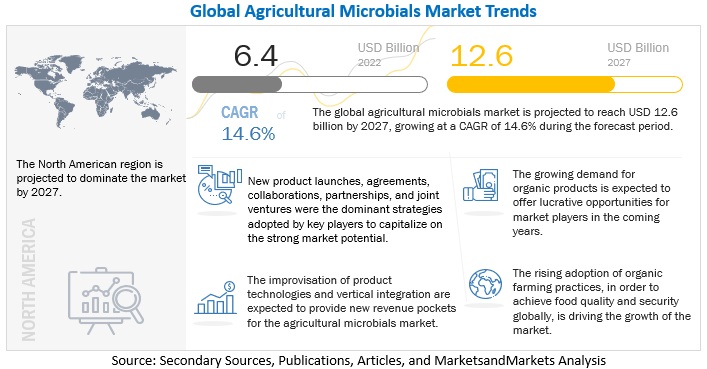The Agricultural Microbials Market is estimated to be valued at USD 6.4 billion in 2022. It is projected to reach USD 12.6 billion by 2027, recording a CAGR of 14.6% according to a new report by MarketsandMarkets™.
The global agricultural microbials market has been influenced by some of the macroeconomic and microeconomic factors witnessed in some key countries. This would prove strong enough to drive the market significantly in terms of value sales during the forecast period. With the decrease in per capita arable land and rise in demand and preference for fruits and vegetables in developing countries, the trend of investing in R&D activities to improve farming techniques has significantly boosted the use of agriculture microbial products in the agriculture industry. The use of microbial biopesticides and biofertilizers in agriculture is gaining importance due to their potential to increase the resilience and yields in farming systems. They enhance nutrient uptake and pest resistance and are helpful in mitigating plant stress responses. The use of microbes is a key practice in sustainable agriculture, thus making them significant for achieving the “Sustainable Development Goals” that are put forth by the United Nations. The future growth in the markets is projected to show tremendous scope for agricultural microbials, and many key industry players have begun field trials, the results of which have determined 10–20% growth in the production of economically important crop plants.

Download PDF Brochure:
https://www.marketsandmarkets.com/pdfdownloadNew.asp?id=15455593
Syngenta AG is one of the global market leaders in products that protect crops.
Syngenta AG is a fully owned subsidiary of China National Agrochemical Corporation (CNAC) Saturn (NL) B.V., a private company incorporated in the Netherlands. The company operates under two segments: Crop Protection and Seeds. Syngenta offers agricultural microbials through its Crop Protection business segment. Through this segment, the company offers selective herbicides, non-selective herbicides, fungicides, insecticides, seed care, controls, and other crop protection products and seed segments consisting of field crops, vegetables, and flowers.
Switzerland, the UK, the US, and China are locations of Syngenta’s most important manufacturing and research & development facilities. Syngenta has significant research labs in Stein, Switzerland, and Jealott’s Hill, UK, dedicated to identifying novel active chemicals. Syngenta’s principal agricultural genomics and biotechnology research facility is based in the US.
Syngenta has a strong global presence with its operations in more than one hundred countries to transform how crops are grown and protected. The Crop Protection segment of the company witnessed significant improvement in sales, owing to the recovery and growth in the Brazilian market alongside new product launches in EMEA and the US. Furthermore, the purchase of Syngenta’s shares by ChemChina (China) raised 98% of Syngenta’s share capital. This transaction can be seen as a strategic move by Syngenta to enter the agricultural market in China, which has shown growth in sustainable agricultural practices. The increased awareness of food safety & quality and the growers’ willingness to invest more for higher yield and quality has provided a platform for Syngenta AG to expand its customer base in China.
The demand for organic food crops and the phase-out of key chemical active ingredients is driving the growth of the agricultural microbials market, owing to the health benefits associated with it.
Agricultural microbials are biocontrol tools used to kill target pests with applications on a wide range of crops. They can either function as parasites, predators, or natural insecticides/fungicides. Awareness of the harmful effects of chemical pesticides, which are responsible for extensive environmental pollution, serious health hazards, outbreaks of secondary pests, resistance developed by target pests, and loss of biodiversity, has been increasing. Therefore, biologicals have gained huge demand in the market.
Based on crop type, the agricultural microbials market is segmented into cereals & grains, oilseeds & pulses, fruits & vegetables, and other crop types. In addition, various crops have been included under distinct categories to emphasize crop-specific pests.
In recent years, there has been a considerable impact on crop yields directly or indirectly due to insect pests and mites. Direct damage may cause burrows in the plant parts, and the damage is augmented by rot caused by bacteria and viruses. Some of the damages caused to plants are the consumption of foliage of cabbage-by-cabbage loopers and foliar damage by aphids and leafhoppers. Indirectly, the insects/fungus may also damage through transmitting plant viruses. These damages may reduce the plant’s vigor and downgrade marketability without any visible evidence of the insect fed. Thrips affect the appearance of fruits and vegetables and reduce their market value. The action threshold may vary with the stage of development of the plant when attacked. Similarly, the threshold for pests causing indirect damage is extremely low if the pests can transmit pathogens. Thus, the action against insects is taken based on the severity of the damage, the value of the crop, and the end use of the crop.
Crops such as ornamentals, fruits, and vegetables are marketed based on their appearance. With the evolving market, there is a demand for clean and healthy-looking food crops, which has resulted in the increased demand for agricultural microbials as an integral part of crop production.
Get 10% Free Customization on this Report:
https://www.marketsandmarkets.com/requestCustomizationNew.asp?id=15455593
Seed treatment by biopesticides helps provide protection against soilborne pests such as white grub and weevils.
In seed treatment, the seed is directly treated/coated with biopesticide prior to planting. This method minimizes exposure of chemicals to workers and potential runoff to waterways, along with reducing the overall number of pesticides used in the environment. It effectively protects the seed and seedling from low-to-moderate pest attacks during emergence and establishment. The treatment creates a layer over the surface of the germinating seed to protect the crop from insects. Seed treatment targets a specific pest without harming the beneficial organisms and minimizes the need for foliar spray.
Many countries are encouraging the use of biological seed treatment methods to promote sustainable methods of pest control. New Zealand started the Next-Generation Bioinsecticides Program in 2012 to find new, safe, and sustainable solutions for New Zealand’s key insect pest and disease problems. As a part of the same program, microbial treatments of wheat seeds were tested on commercial farms in Canterbury for their ability to protect seedlings from grass grub attacks. It was found that seeds treated with insecticidal bacteria resulted in higher yields than untreated seeds where grass grub was present. Such benefits of using seed treatment are expected to boost the growth of this segment.
North America is projected to reach USD 4.3 Billion during the forecast period.
North America is a key exporter of agricultural products. Factors such as growth in organic farming, availability of water and land and etrepreneurial farmers, and efficient infrastructure are the key competitive advantages for the North American market.
The Agricultural Improvement Act was established in the region in 2018, under which the government has established permanent funding for organic research and made efforts to enhance organic trade. The farm practices using biofertilizers and biopesticides are significantly rising in the Canadian region, despite the decrease in the total number of farmlands.
The key players in this market include FMC Corporation (US), Corteva Agriscience (US), Marrone Bio innovations (US), Valent Biosciences (US).
Related Reports:
Biostimulants Market Report till 2026: by Active Ingredient (Humic Substances, Amino Acids, Seaweed Extracts, Microbial Amendments), Crop Type (Fruits & Vegetables, Cereals, Turf & Ornamentals), Application Method, Form and Region
Biofertilizers Market Report Industry till 2026: Market growth by Form (Liquid, Carrier-Based), Mode of Application (Soil Treatment, Seed Treatment), Type (Nitrogen-fixing, Phosphate solubilizing & Mobilizing, Potash Solubilizing & Mobilizing), Crop Type, and Region
Biological Seed Treatment Market Report up to 2025: Players, Forecast and Revenue Opportunities | By Type (Microbials and Botanicals), Crop (Corn, Wheat, Soybean, Cotton, Sunflower, and Vegetable Crops), Function (Seed Protection and Seed Enhancement), and Region
Biopesticides Market by Type (Bioinsecticides, Biofungicides, Bionematicides, and Bioherbicides), Source (Microbials, Biochemicals, and Beneficial Insects), Mode of Application, Formulation (Dry, Liquid), Crop Type and Region – Global Forecast to 2027
About MarketsandMarkets™
MarketsandMarkets™ provides quantified B2B research on 30,000 high growth niche opportunities/threats which will impact 70% to 80% of worldwide companies’ revenues. Currently servicing 7500 customers worldwide including 80% of global Fortune 1000 companies as clients. Almost 75,000 top officers across eight industries worldwide approach MarketsandMarkets™ for their painpoints around revenues decisions.
Our 850 fulltime analyst and SMEs at MarketsandMarkets™ are tracking global high growth markets following the “Growth Engagement Model – GEM”. The GEM aims at proactive collaboration with the clients to identify new opportunities, identify most important customers, write “Attack, avoid and defend” strategies, identify sources of incremental revenues for both the company and its competitors. MarketsandMarkets™ now coming up with 1,500 MicroQuadrants (Positioning top players across leaders, emerging companies, innovators, strategic players) annually in high growth emerging segments. MarketsandMarkets™ is determined to benefit more than 10,000 companies this year for their revenue planning and help them take their innovations/disruptions early to the market by providing them research ahead of the curve.
MarketsandMarkets’s flagship competitive intelligence and market research platform, “Knowledge Store” connects over 200,000 markets and entire value chains for deeper understanding of the unmet insights along with market sizing and forecasts of niche markets.
Media Contact
Company Name: MarketsandMarkets™ Research Private Ltd.
Contact Person: Mr. Aashish Mehra
Email: Send Email
Phone: 18886006441
Address:630 Dundee Road Suite 430
City: Northbrook
State: IL 60062
Country: United States
Website: https://www.marketsandmarkets.com/Market-Reports/agricultural-microbial-market-15455593.html
